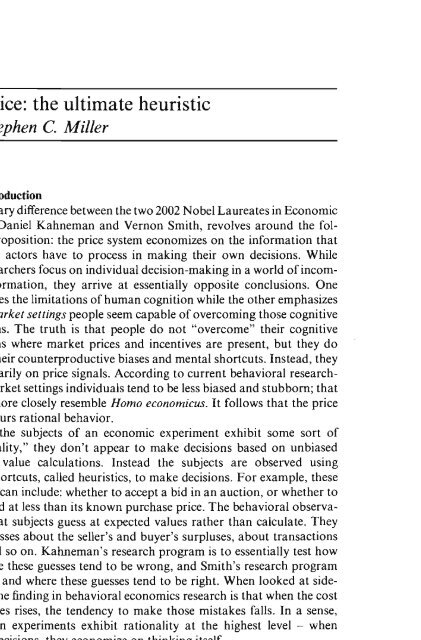Handbook on Contemporary Austrian Economics
Handbook on Contemporary Austrian Economics
Handbook on Contemporary Austrian Economics
You also want an ePaper? Increase the reach of your titles
YUMPU automatically turns print PDFs into web optimized ePapers that Google loves.
5 Price: the ultimate heuristic<br />
Stephen C. Miller<br />
5.1 Introducti<strong>on</strong><br />
The primary difference between the two 2002 Nobel Laureates in Ec<strong>on</strong>omic<br />
Science, Daniel Kahneman and Vern<strong>on</strong> Smith, revolves around the following<br />
propositi<strong>on</strong>: the price system ec<strong>on</strong>omizes <strong>on</strong> the informati<strong>on</strong> that<br />
ec<strong>on</strong>omic actors have to process in making their own decisi<strong>on</strong>s. While<br />
both researchers focus <strong>on</strong> individual decisi<strong>on</strong>-making in a world of incomplete<br />
informati<strong>on</strong>, they arrive at essentially opposite c<strong>on</strong>clusi<strong>on</strong>s. One<br />
emphasizes the limitati<strong>on</strong>s of human cogniti<strong>on</strong> while the other emphasizes<br />
how in market settings people seem capable of overcoming those cognitive<br />
limitati<strong>on</strong>s. The truth is that people do not "overcome" their cognitive<br />
limitati<strong>on</strong>s where market prices and incentives are present, but they do<br />
discard their counterproductive biases and mental shortcuts. Instead, they<br />
rely primarily <strong>on</strong> price signals. According to current behavioral researchers,<br />
in market settings individuals tend to be less biased and stubborn; that<br />
is, they more closely resemble Homo ec<strong>on</strong>omicus. It follows that the price<br />
system spurs rati<strong>on</strong>al behavior.<br />
When the subjects of an ec<strong>on</strong>omic experiment exhibit some sort of<br />
"irrati<strong>on</strong>ality," they d<strong>on</strong>'t appear to make decisi<strong>on</strong>s based <strong>on</strong> unbiased<br />
expected value calculati<strong>on</strong>s. Instead the subjects are observed using<br />
mental shortcuts, called heuristics, to make decisi<strong>on</strong>s. For example, these<br />
decisi<strong>on</strong>s can include: whether to accept a bid in an aucti<strong>on</strong>, or whether to<br />
sell a good at less than its known purchase price. The behavioral observati<strong>on</strong><br />
is that subjects guess at expected values rather than calculate. They<br />
make guesses about the seller's and buyer's surpluses, about transacti<strong>on</strong>s<br />
costs, and so <strong>on</strong>. Kahneman's research program is to essentially test how<br />
and where these guesses tend to be wr<strong>on</strong>g, and Smith's research program<br />
tests how and where these guesses tend to be right. When looked at sideby-side,<br />
the finding in behavioral ec<strong>on</strong>omics research is that when the cost<br />
of mistakes rises, the tendency to make those mistakes falls. In a sense,<br />
subjects in experiments exhibit rati<strong>on</strong>ality at the highest level - when<br />
making decisi<strong>on</strong>s, they ec<strong>on</strong>omize <strong>on</strong> thinking itself.<br />
Market actors are not perfect calculators of costs and benefits. Bias<br />
exists, and it is often costly. Bargaining can fail, viable profit opportunities<br />
are sometimes aband<strong>on</strong>ed, and c<strong>on</strong>sumers often experience remorse.<br />
Behavioral ec<strong>on</strong>omics provides a valuable approach for understanding

















